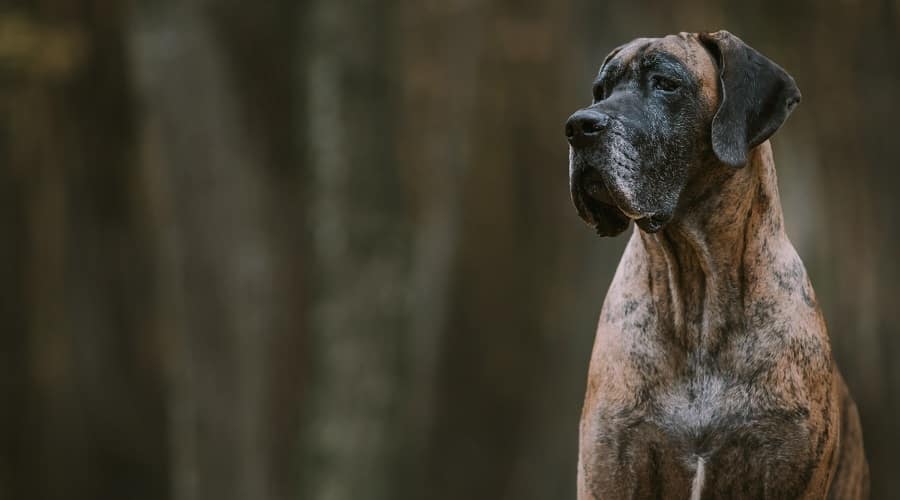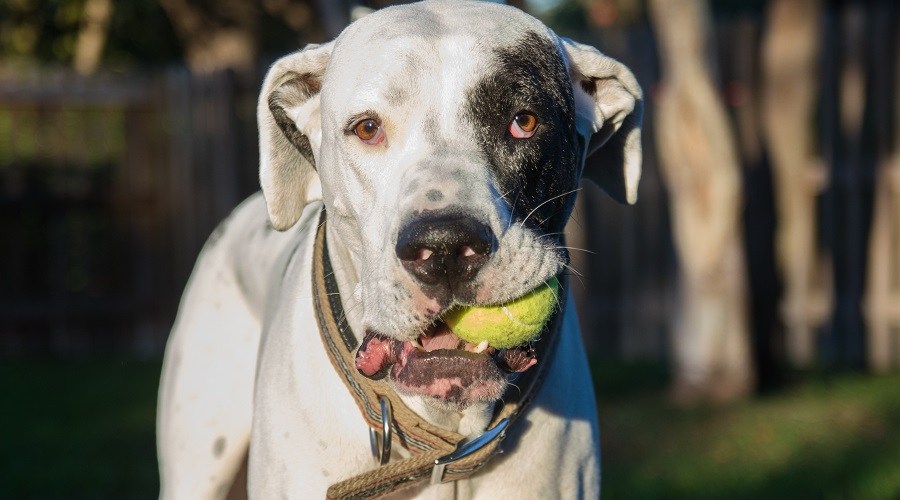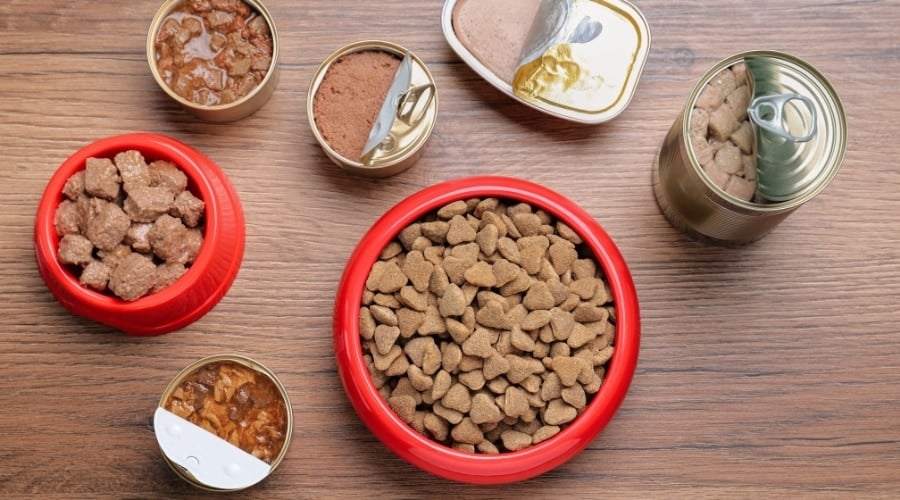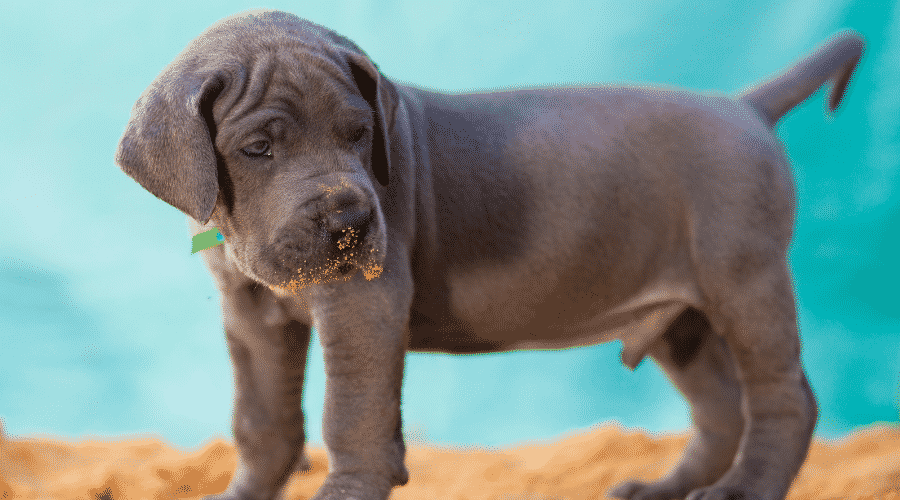Great Dane Pitbull Mixes (aka Great Danebulls) are sweet but needy dogs who thrive on attention. For that reason, they are best for families who can devote a lot of time and energy to them. If this breed is left home alone often, they can suffer from severe separation anxiety.
Their gentle, loving nature makes them great with children and other dogs. Due to their high energy, it’s important to teach them proper behavior at a young age. Luckily, they are intelligent and eager to please, allowing for easy training if done consistently and firmly.
While many families love these dogs, unfortunately, they can end up in shelters or rescue organizations. It’s wonderful to start by looking to adopt a new puppy rather than buy one from a breeder. Not only can it save a life; it can also save you some money.
Breed History
The origin of the Great Danebull is not well documented, but learning about the background of the two-parent breeds can be helpful in understanding the mix.
Great Danes

Ancestors of Great Danes are thought to trace back to ancient times with drawings of dogs looking similar to Danes on Egyptian artifacts. They were likely brought to other parts of the world by Assyrians who traded the dogs with Greece and Italy.
When they made their way to Germany, they were used for hunting wild boar. In fact, their early name was “Boar Hounds” to symbolize their role in society. But around the 1600s, their role began to shift, and they became dogs associated with German nobility. Nobles would save the best-looking dogs and keep them inside their homes, causing their names to be changed to “chamber dogs.”
It was not until around the 1700s that their name was changed to “Great Dane” after a Frenchman traveled to Denmark and saw this new breed. The name stuck despite the dog having no Danish origins. In 1880, German officials held a vote and determined the dog would be called Deutsche Dogge, meaning German Dog, but the name did not stick in English-speaking countries.
Great Danes kept their status as prestigious dogs through the 18th Century, where they stood as guardians of carriages and estates. The move from hunting wild boars to keeping nobles company has caused the breed to become a gentle, affectionate breed. The American Kennel Society first recognized the Great Dane as a breed in 1887, making it the 34th breed. They are currently the 16th most popular breed.
Pitbull

Pitbulls were bred from Old English Bulldogs, who were used to participating in “bull baiting.” Bull baiting was a cruel form of entertainment that required dogs to chase bulls for hours until the animal collapsed from fatigue. The British Parliament outlawed this practice in 1835, causing a shift to “batting.” The public would watch on as these dogs tried to kill as many rats as possible. This is where the “it” in Pitbull comes from, referring to a pit where rats were placed so they could not escape.
After some time, this no longer entertained the public, and they turned their attention to dogfighting, starting the long and cruel history of this breed. Despite their use as fighting dogs, Pitbulls were bred to be docile and towards humans, who are the cause for their affectionate nature today.
Pitbulls first came to the United States shortly before the Civil War when people from the British Isles began immigrating to the country. Life was less cruel to the breed in America, and they soon began being used for a variety of things. They were used to herd cattle and sheep, guard livestock and families against wild animals and thieves, and help on hunts. Furthermore, their loyalty and affection towards their owners quickly turned them into family companions.
During WWI and WWII, Pitbulls were used on many advertisements as the national mascot. They were also the first dog the United States used during wartime. Despite their popularity and storied history within the country, the American Kennel Club does not recognize them as a breed. The United Kennel Club and the American Dog Breeders Association do recognize the breed.
Temperament

It’s really no surprise the unlikely mixture of this breed creates an affectionate dog given both Great Danes and Pitbulls are known people pleasers. They are playful, loyal, and loving making them a great dog for a family.
These dogs are great with children, but it’s important to teach your child how to act around your new dog, as with most dogs, they can react negatively to hair pulling or hitting. Due to the large size and playful nature of this breed, it’s also a good idea to keep an eye on your children while playing with a dog, so they are not knocked over unintentionally.
They are happiest when they are cuddling with their family and think they are lap dogs despite their large size. They enjoy running and playing outside with their owners to burn off their energy. Due to their outgoing nature, if these dogs are socialized at a young age, they are great around other people and animals.
These dogs are truly attention seekers and demand attention from their owners when they are home. Their desire for companionship means they can suffer from severe separation anxiety. This can cause the dog to become stressed and take part in destructive activities like barking, chewing, or digging.
Highly intelligent and eager to please their owner, this dog is generally easy to train if done correctly. Commands are learned easily and due to their clingy nature, they respond best to positive reinforcement. Since it is a hybrid dog, the temperament can vary from puppy to puppy. The best way to determine the personality of the puppy is by looking at parents and other offspring.
Size & Appearance
The Great Dane Pitbull Mix is a large to giant-sized dog. They can weigh anywhere from 60 to 100 pounds and stand 24 to 30 inches. Their long, lean body more closely resemblances a Great Dane than the muscular body of a Pitbull. You can expect them to have long legs with large paws.
Their ears are typically short, square-shaped, and hang loosely resembling closer to a Pitbull than a Great Dane. Their coats range in color but are usually mixed depending on the coloring of their parents. They can be white, black, fawn, blue, brown, red, brindle, sable, or a combination of these colors. Their long tail usually curls slightly upwards.
The Great Dane Pitbull mix has a short, glossy, smooth, and stiff coat. Their coat is slightly dense, but extra care does need to be given during cold months, such as providing your dog a coat. They can handle warm weather better but do not tolerate extreme heat.
Exercise Needs & Living Requirements
When considering adopting a Great Dane Pitbull, it is important to remember that they will need a lot of space and time to exercise. This large breed has a lot of energy and will need a lot of space to run around. These dogs are best for families that have a large backyard to play in and are not ideal for apartment dwellers. However, if you do live in an apartment, these dogs can adapt if they are given a lot of exercise throughout the day in order to burn off their energy.
On average, these dogs need about an hour to an hour and a half of exercise per day. This can be done through walks, runs, or simply playing in your backyard. These dogs are very playful and enjoy playing catch, tug-of-war, or completing different obstacle courses. When purchasing toys, remember these dogs are large, with a strong mouth, and need toys that can handle strong pulling.
Training
Intelligent and eager to please Great Dane Pitbull mixes are relatively easy to train. The dog’s intelligence makes it easy for them to understand commands from their owners. However, you must stay firm and consistent during training. This is to gain the respect and trust of the dog. If you sway on different actions, it could confuse the dog and make them not listen.
Due to the clingy nature of this dog, they respond best to positive reinforcement during training, so training should always be done in a positive way. As with most breeds, puppies are easier to train than adults, but both can be done.
A puppy mix should begin training and socialization at a young age to begin learning proper manners. This breed has a lot of energy, so it will be important to train them when it is a proper time to use their energy. With repetition, this puppy should begin forming good habits relatively quickly.
If you adopt an untrained adult mix, it is not impossible to train them, but it could prove a larger task. These dogs will already be set in their ways, so patience is key with them. With a lot of effort, patience, and skill, you should begin to see changes in your dog’s behavior.
Health

Overall, this breed is pretty healthy, but there are some health issues that can be inherited from the parent breed. To prevent the risk of adopting a dog with one of these health concerns, you can obtain a copy of the parent’s medical records.
Hip Dysplasia
Hip Dysplasia is a genetic disease that causes mild to severe changes to the inner workings of the hip joint. It’s when the ball portion of the femur aligns poorly with the pelvis hip socket resulting in a very painful and expensive condition to treat.
Cardiomyopathy
This trait comes from the Great Dane side of the bloodline. Great Danes are the second most likely breed to develop this condition. This heart disease causes irregular heartbeats. It can come about quickly and can cause the dog to faint or collapse or suddenly die. It can be controlled through medication, making it possible to live a full life.
Bloat
This is another condition that comes from the Great Dane. Known formally as gastric dilatation volvulus, this is a very serious condition that must be treated quickly. It causes a sudden increase in stomach gas and twisting causing the blood vessels that supply the stomach to become twisted. This leads to irreversible stomach death, shock, and release of deadly toxins if it is not treated.
Cancer
This breed is susceptible to developing several different kinds of cancers, especially bone cancer. This again comes more from the Great Dane side. If caught early, cancer can be treatable in most dogs. However, it can require costly chemo or even amputation of limbs. As with every breed, consistent vet appointments and proper care and nutrition can help your dog live a long, healthy life.
Nutrition

This large dog has a large appetite and needs between 3 to 6 cups of food a day. This can cost the owner $55 or more a month, depending on the dog food brand.
They do best with high-quality dry dog food that is made specifically for large breed dogs. Make sure there is plenty of fresh water available and provide daily fish oil or glucosamine supplements.
Dog Food Suggestions
Make sure the food you select is both protein-rich and high-quality. There shouldn’t be any artificial ingredients or fillers in your dog’s food. Here are some options to consider:
- The Farmer’s Dog fresh, human-grade recipes
- American Journey Salmon & Sweet Potato Recipe Grain-Free Dry
- Taste of the Wild High Prairie Grain-Free Dry
- Ollie Healthy Turkey Feast Fresh Dog Food
This breed might be at risk for bloat, which can occur when a dog eats too fast. If you notice your pup is inhaling his food, buy him a slow feeder. This is also a great way to exercise his mind – two for one.
Grooming
It is relatively easy to groom your Great Dane Pitbull, but they are heavy shedders, so your home and furniture will need constant cleaning to keep their hair at bay. While they require daily brushing, their short hair makes it a breeze. Avoid giving them too many baths as it can prevent natural oil production, instead only bathe them when they are dirty.
Their ears should be checked and cleaned at least once a week. They also require nail trims occasionally; this can be done by a professional groomer if you are not comfortable doing this yourself on such a large dog. Additionally, their teeth should be brushed at least every three days to ensure proper dental health.
Here are the tools you’ll need:
- De-matter
- Comb
- Deshedder
- Nail clippers
- Ear cleaner
Breeders & Puppy Costs

Several breeders specialize in hybrid breeding. They are an excellent place to start looking. When purchasing from a breeder, it’s essential to make sure they are reputable and should show the health history and temperament of the parents.
Additionally, several organizations specializing in Great Danes or Pitbulls could have mixed puppies at their organizations. You should usually expect to spend around $600-$1,000 from a breeder on a puppy.
Rescues & Shelters
There are several Great Dane Pitbulls in shelters and rescue organizations and should always be your first place to look. Buying from a rescue shelter or adoption agency not only can save the dog’s life but can allow you to have more money to spend on caring for your dog.
- Rescue Me – This is a great organization that specializes in helping animals of all kinds get adopted. You are able to search by dog breed and state to help find the dog that is closest to you. Due to their large database, it is likely you will be able to find the mix you are looking for.
- Pitbull Rescue Central – This organization specializes in rescuing Pitbulls and their mixes. They have volunteers throughout the country, so you are likely to find a foster home or shelter near you.
Adoption costs will vary from rescue organization or shelter but will generally be less than a breeder.
As Family Pets
Great Dane Pitbulls make for a wonderful family pet. They are generally:
- Affectionate and loving
- Easy-going
- Great for families
- Clingy and need a lot of attention from owners
- Like to act like lap dogs, despite their large size
- Prone to suffer from separation anxiety if left alone for long periods of time
- Playful and energetic, requiring a lot of exercise
- Intelligent
- Benefits from training at a young age to learn proper behavior
Final Thoughts
Loving, loyal, and affectionate, Great Dane Pitbulls are for people who want a dog’s undivided attention. This large dog craves attention and love from its owner and constantly wants to be around its family. This need for attention means he does not do well with families who are not home often as they can suffer from separation anxiety.
This playful breed makes an excellent family dog who gets along with children and other animals alike. Due to the dog’s large size, it is necessary that parents watch young children when playing with the dog. Full of energy, this dog needs a lot of time devoted to exercise, whether it is going out for a run or playing fetch. They do best with families that have large yards for the dog to run.
If you are willing to give a lot of attention and love to your Great Danebull, they can make a wonderful addition to your family.





